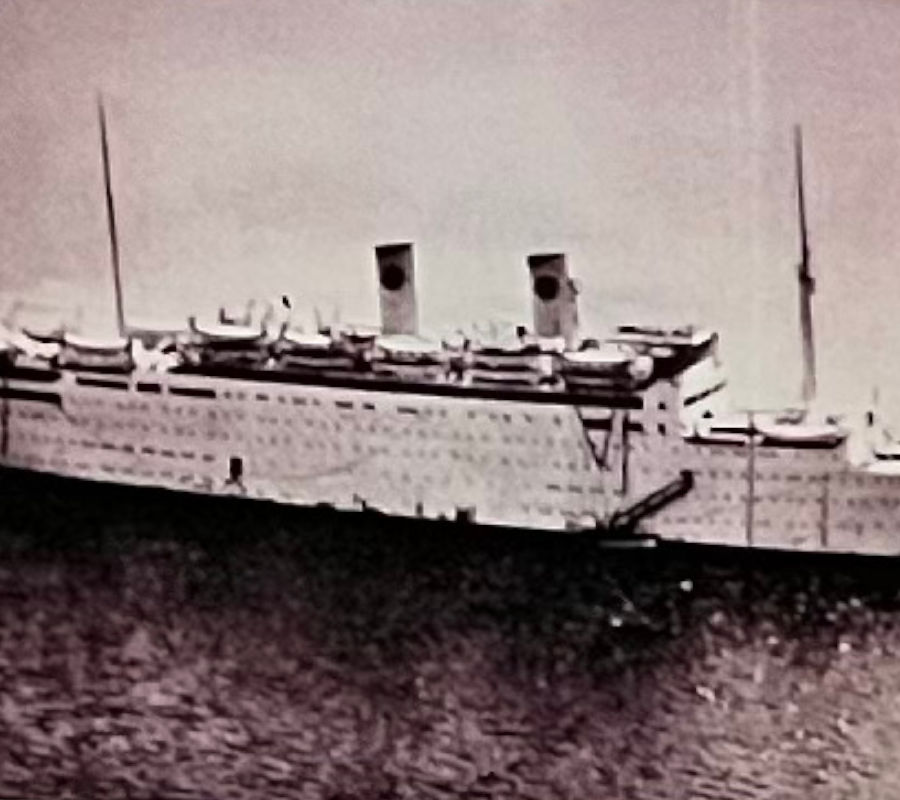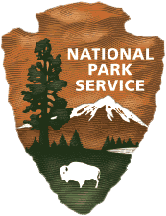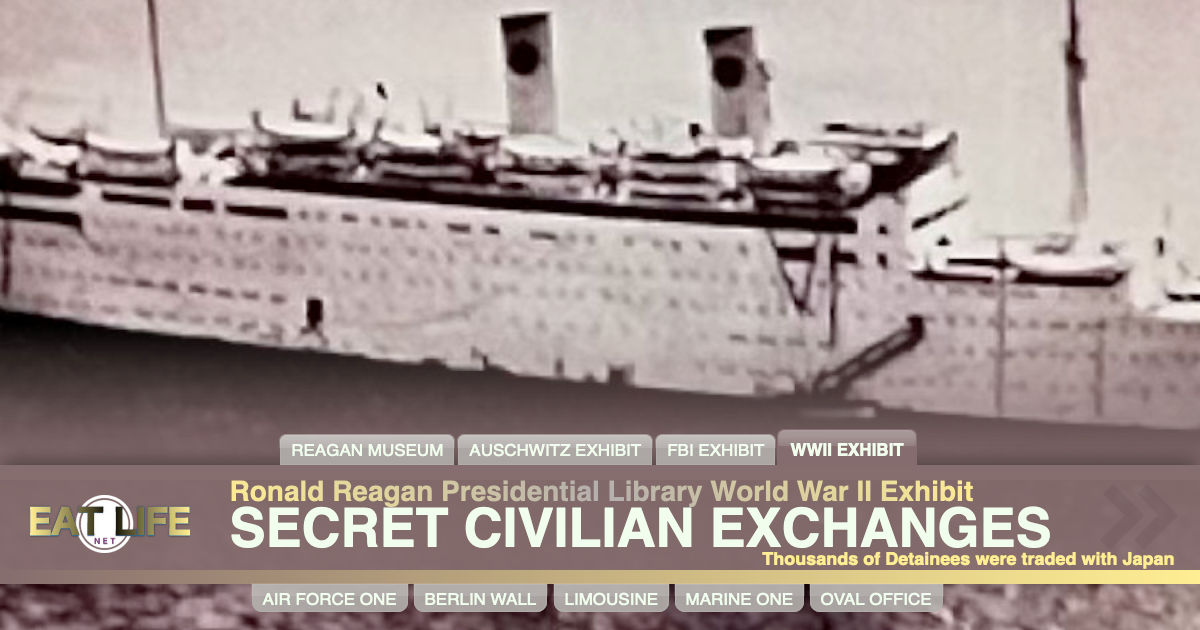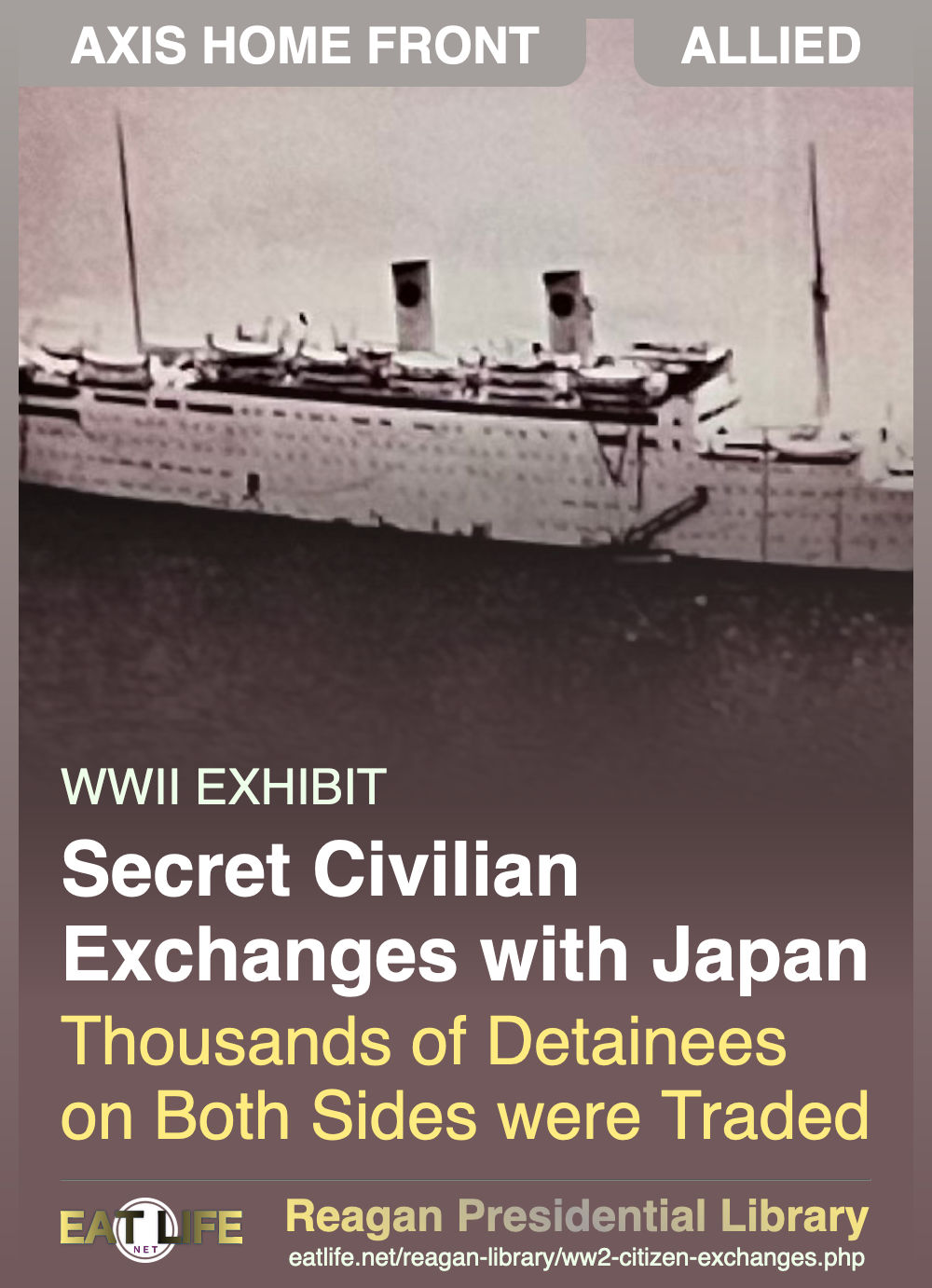After Pearl Harbor, thousands of civilians on both sides were taken into custody. American citizens were held in camps by the Japanese and in the US, non American Japanese were evacuated away from the coasts to inland camps administered by the War Relocation Authority. Talks to repatriate each other's detainees were quickly begun. These secret exchanges benefited both countries. From 1942 to 1946 the Swedish luxury liner MS Gripsholm made 12 round trips, carrying a total of 27,712 repatriates.
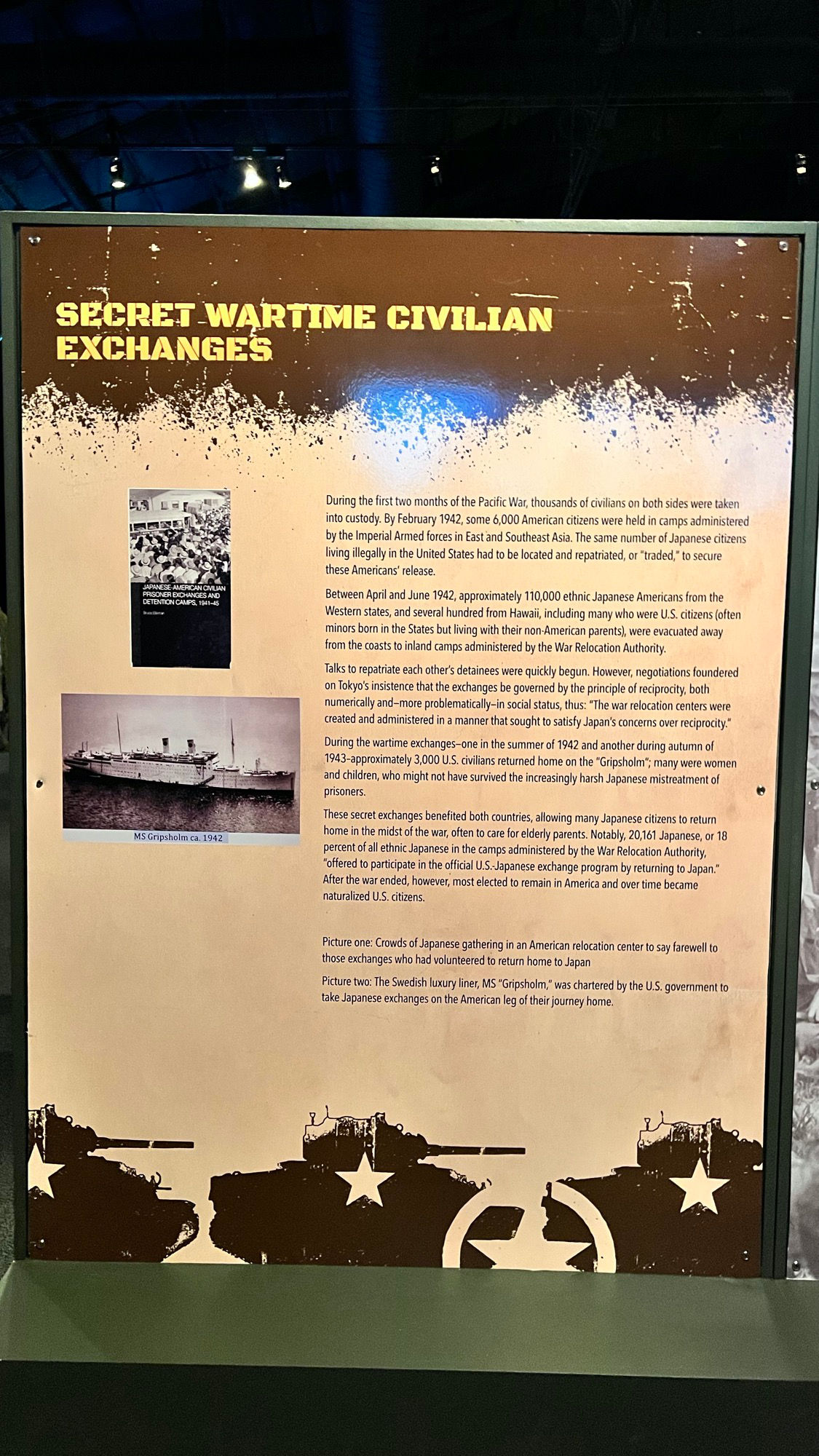
During the first two months of the Pacific War, thousands of civilians on both sides were taken into custody.
By February 1942, some 6,000 American citizens were held in camps administered by the Imperial Armed forces in East and Southeast Asia. The same number of Japanese citizens living illegally in the United States had to be located and repatriated, or "traded," to secure these Americans' release.
Between April and June 1942, approximately 110,000 ethnic Japanese Americans from the Western states, and several hundred from Hawaii, including many who were U.S. citizens (often minors born in the States but living with their non American parents), were evacuated away from the coasts to inland camps administered by the War Relocation Authority.
Talks to repatriate each other's detainees were quickly begun. However, negotiations foundered on Tokyo's insistence that the exchanges be governed by the principle of reciprocity, both numerically and - more problematically - in social status, thus: "The war relocation centers were created and administered in a manner that sought to satisfy Japan's concerns over reciprocity."
During the wartime exchanges - one in the summer of 1942 and another during autumn of 1943 - approximately 3,000 U.S. civilians returned home on the "Gripsholm"; many were women and children, who might not have survived the increasingly harsh Japanese mistreatment of prisoners.
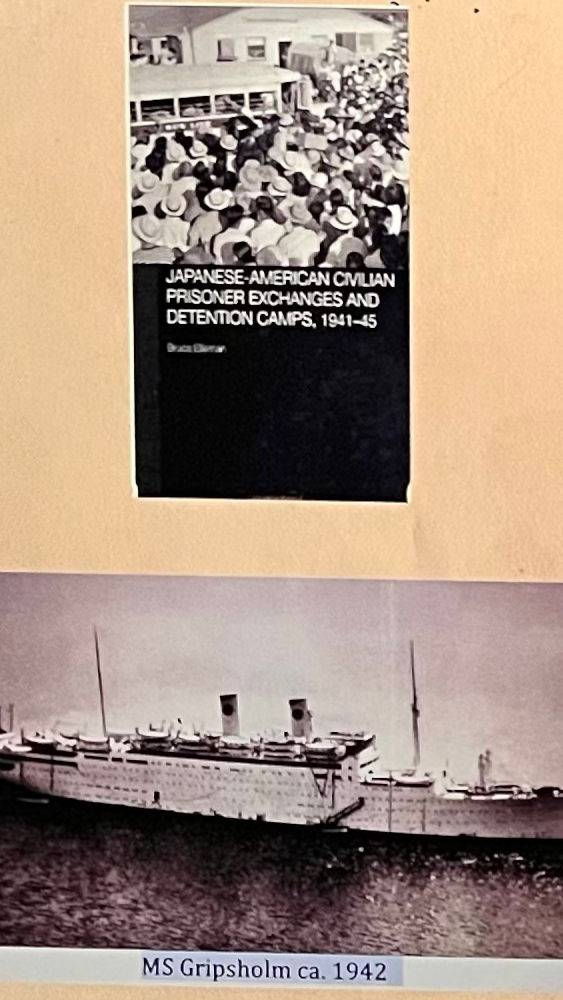 These secret exchanges benefited both countries, allowing many Japanese citizens to return home in the midst of the war, often to care for elderly parents.
Notably, 20,161 Japanese, or 18 percent of all ethnic Japanese in the camps administered by the War Relocation Authority, "offered to participate in the official U.S. Japanese exchange program by returning to Japan."
After the war ended, however, most elected to remain in America and over time became naturalized U.S. citizens.
These secret exchanges benefited both countries, allowing many Japanese citizens to return home in the midst of the war, often to care for elderly parents.
Notably, 20,161 Japanese, or 18 percent of all ethnic Japanese in the camps administered by the War Relocation Authority, "offered to participate in the official U.S. Japanese exchange program by returning to Japan."
After the war ended, however, most elected to remain in America and over time became naturalized U.S. citizens.
Picture one: Crowds of Japanese gathering in an American relocation center to say farewell to those exchanges who had volunteered to return home to Japan
Picture two: The Swedish luxury liner, MS "Gripsholm," was chartered by the U.S. government to take Japanese exchanges on the American leg of their journey home.
History.comOn March 18, the War Relocation Authority is created to “Take all people of Japanese descent into custody, surround them with troops, prevent them from buying land, and return them to their former homes at the close of the war.”Anger toward and fear of Japanese Americans began in Hawaii shortly after the bombing of Pearl Harbor; everyone of Japanese ancestry, old and young, prosperous and poor, was suspected of espionage. This suspicion quickly broke out on the mainland; as early as February 19, 1942, President Franklin D. Roosevelt ordered that German, Italian and Japanese nationals-as well as Japanese American citizens-be barred from certain areas deemed sensitive militarily. California, which had a significant number of Japanese American residents, saw a particularly virulent form of anti-Japanese sentiment, with the state’s attorney general, Earl Warren (who would go on to be the chief justice of the United States), claiming that a lack of evidence of sabotage among the Japanese American population proved nothing, as they were merely biding their time.
While roughly 2,000 people of German and Italian ancestry were interned during this period, Americans of Japanese ancestry suffered most egregiously. The War Relocation Authority, established on March 18, 1942, was aimed at them specifically: 120,000 men, women, and children were rounded up on the West Coast. Three categories of internees were created: Nisei (native U.S. citizens of Japanese immigrant parents), Issei (Japanese immigrants), and Kibei (native U.S. citizens educated largely in Japan). The internees were transported to one of 10 Relocation Centers in California, Utah, Arkansas, Arizona, Idaho, Colorado and Wyoming.
The quality of life in a Relocation Center was only marginally better than prison: Families were sardined into 20- by 25-foot rooms and forced to use communal bathrooms. No razors, scissors, or radios were allowed. Children attended War Relocation Authority schools.
National Park ServiceWar Relocation Centers
During World War II, the US Immigration and Naturalization Service, part of the US Department of Justice, held more than 7,000 immigrants of Japanese Ancestry, and some citizens. There were 27 Department of Justice camps, eight of which (in Texas, Idaho, North Dakota, New Mexico, and Montana) held people of Japanese ancestry. The camps were guarded by US Border Patrol agents rather than miltary police and were intended for non-citizens including Buddhist and Shinto ministers, Japanese language teachers, newspaper workers, and other community leaders.The US State and Justice Departments took 2,210 persons of Japanese ancestry from 12 Latin American countries and held them in Department of Justice camps. Approximately 1,800 were Japanese Peruvians. The U.S. intended to use them in potential hostage exchanges with Japan. After the war, 1,400 were refused return to their Latin American homes and more than 900 Japanese Peruvians were “voluntarily” deported to Japan. Three hundred fought deportation in the courts and were eventually allowed to settle in the U.S. At least 14 US Army facilities also held people of Japanese ancestry during World War II. Four of the facilities were in Hawaii, one was in Alaska; the remaining nine facilities were in the contiguous United States.
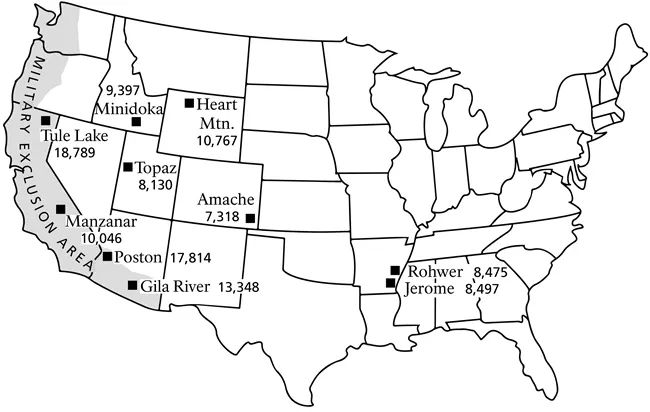
- Manzanar
- Location: Inyo County, California
- Environmental Conditions: Located at 3,900 feet at the eastern base of the Sierra Nevada in the Owens Valley. Temperatures reach well over 100 degrees in summer and below freezing in winter. Strong winds and dust storms are frequent.
- Acreage: 6,000
- Opened: March 21, 1942 (Owens Valley Reception Center); June 1, 1942 (Manzanar War Relocation Center).
- Closed: November 21, 1945
- Max. Population: 10,046 (September 22, 1942)
- Demographics: Most people were from the Los Angeles area, Terminal Island, and the San Fernando Valley. Others came from the San Joaquin Valley and Bainbridge Island, Washington; the latter transferred to Minidoka in 1943.
- Tule Lake
- Location: Modoc County, California
- Environmental Conditions: Tule Lake War Relocation Center was located at an elevation of 4,000 feet on a flat and treeless terrain with sandy soil. Winters are long and cold and summers hot and dry. Vegetation is sparse.
- Acreage: 7,400
- Opened: May 25, 1942
- Closed: March 20,1946
- Max. Population: 18 ,789 (December 25, 1944)
- Demographics: Originally, more than 3,000 people were sent directly to Tule Lake from the Sacramento, Pinedale, Pomona, Salinas, and Marysville assembly centers. Once Tule Lake became a segregation center, the population came from all other camps and Hawaii.
- Topaz (Central Utah)
- Location: Millard County, 16 miles NW of Delta, UT.
- Environmental Conditions: elevation 4,600 ft, within the Sevier Desert – high desert brush with high winds and temperatures ranging from 106 degrees in summer to -30 degrees in winter.
- Acreage: 19,800
- Opened: September 11, 1942
- Closed: October 31, 1945 Max. Population: 8,130 (March 17, 1943)
- Demographics: People came primarily from the San Francisco Bay Area, predominantly from Tanforan Assembly Center.
- Heart Mountain
- Location: Park County, Wyoming
- Environmental Conditions: Located on a terrace of the Shoshone River at an elevation of 4,700 feet. The terrain was open sagebrush desert.
- Acreage: 20,000
- Opened: August 11, 1942
- Closed: November 10, 1945
- Max. Population: 10,767 (January 1, 1943)
- Demographics: Most people came from Los Angeles, Santa Clara, and San Francisco counties in California and Yakima and Washington counties in Washington. Many came through the Santa Anita and Pomona assembly centers in CA.
- Minidoka (Hunt)
- Location: Jerome County, Idaho Environmental Conditions: elevation 4,000 ft – high desert. Temperatures ranged from the low 100s in summer to –30 in the winter. When the rains came in autumn the entire camp turned to mud, often knee deep.
- Acreage: 33,000
- Opened: August 10, 1942
- Closed: October 28, 1945
- Max. Population: 9,397 (March 1, 1943)
- Demographics: People primarily came from Seattle, WA, Portland, OR, and surrounding areas. In 1943, 1,900 incarcerees from Tule Lake and 227 incarcerees from Manzanar (originally from Bainbridge Island, WA) were transferred to Minidoka at their request. Additionally, approximately 200 Japanese Alaskans were incarcerated at Minidoka.
- Granada (Amache)
- Location: Prowers County, Colorado
- Environmental Conditions: Located on a hilltop at 3,500 ft., Granada was arid and dusty.
- Acreage: 10,500
- Opened: August, 27, 1942
- Closed: January 27, 1946
- Max Population: 7,597 (October 1942)
- Demographics: Most people came from Los Angeles, Sonoma, Yolo, Stanislaus, Sacramento, and Merced counties via the Merced and Santa Anita assembly centers. The population was equally split between urban and rural backgrounds.
- Gila River
- Location: Southern Arizona
- Environmental Conditions: Located in the desert, temperatures reached 125 degrees, with summer temperatures consistently over 100 degrees. Dust storms were also a frequent problem.
- Opened: July 10, 1942
- Closed: Canal Camp: September 28, 1945
- Butte Camp: November 10, 1945
- Max. Population: 13,348 (November 1942)
- Demographics: People primarily came from Fresno, Santa Barbara, San Joaquin, Solano, Contra Costa, Ventura and Los Angeles Counties via the Turlock, Tulare, and Santa Anita assembly centers. Three thousand people came directly to Gila River from their west coast homes.
- Poston (Colorado River)
- Location: La Paz County, AZ (Yuma County during WWII)
- Environmental Conditions: elevation 320 ft – lower Sonoran desert near Colorado River – perhaps the hottest of all the camps.
- Acreage: 71,000. Poston was the largest camp by area.
- Opened: BIA administered the center when it was an assembly center, and after it became a relocation center until December 1943 when WRA took full control. Date of first arrival was May 8, 1942
- Closed: November 28, 1945
- Max. Population: 17,814 (September 2, 1942)
- Demographics: People were from Kern County, Fresno, Monterey Bay Area, Sacramento County, southern Arizona, and southern CA (including San Diego). They came from the Mayer, Salinas, Santa Anita, and Pinedale assembly centers.
- Rohwer
- Location: Desha County, Arkansas
- Environmental Conditions: Rohwer War Relocation Center was located five miles west of the Mississippi River in a swampy area intertwined with canals, creeks, and bayous. Forests had once covered the area, but by 1940 had been replaced by agricultural fields. Rohwer was at an elevation of 140 feet.
- Acreage: 10,161
- Opened: September 18, 1942
- Closed: November 30, 1944
- Max. Population: 8,475 (March 11, 1943)
- Demographics: Most people incarcerated at Rohwer War Relocation Center came from Los Angeles and San Joaquin counties in California via the Santa Anita and Stockton assembly centers.
- Jerome
- Location: Chicot and Drew Counties, Arkansas
- Environmental Conditions: Jerome War Relocation Center was located 12 miles from the Mississippi River at an elevation of 130 feet. The area was once covered with forests, but has become primarily agricultural land. The Big and Crooked Bayous flowed from north to south in the central and eastern part of the relocation center.
- Acreage: 10,000
- Opened: October 6, 1942
- Closed: June 1944
- Max. Population: 8,497 (November 1942)
- Demographics: Most people incarcerated at Jerome War Relocation Center came from Los Angeles, Fresno, and Sacramento counties in California, through the Santa Anita and Fresno assembly centers. 811 people came from Hawaii.
Formulated and executed a program for removal, relocation, maintenance, and supervision, in 10 interior relocation centers, of persons (principally of Japanese ancestry) excluded from military areas designated in accordance with EO 9066, February 19, 1942. Operated, under policy guidance of War Refugee Board, the Fort Ontario Emergency Refugee Shelter (Oswego, NY) for European refugees, August 1944-June 1945. After revocation by the Western Defense Command, December 17, 1944, of west coast general exclusion order, effective January 2, 1945, WRA primarily involved in resettling Japanese-American internees.General records
- General subject files, 1942-46 General and topical final reports, 1946
- General and report files ("Basic Documentation Files") consolidated from records of headquarters and field units to document the work of WRA, including resettlement of evacuees; and activities and conditions in WCCA assembly centers, WRA relocation centers and area relocation offices, and the Fort Ontario Emergency Refugee Shelter, 1941-46
- WRA serial issuances, 1942-45, and nonserial issuances, 1942-46
- Reference files of non-WRA issuances, 1942-46
- Magazine articles, with indexes, 1942-46
- Newsletter relating to Japanese-American evacuees, 1942-46
- Japanese-American newspapers, 1942-47
WIKIPEDIAThe War Relocation Authority (WRA)
United States government agency established to handle the internment of Japanese Americans during World War II. It also operated the Fort Ontario Emergency Refugee Shelter in Oswego, New York, which was the only refugee camp set up in the United States for refugees from Europe. The agency was created by Executive Order 9102 on March 18, 1942, by President Franklin D. Roosevelt, and was terminated June 26, 1946, by order of President Harry S. Truman.After the December 1941 attack on Pearl Harbor, President Franklin D. Roosevelt issued Executive Order 9066, authorizing military commanders to create zones from which certain persons could be excluded if they posed a threat to national security. Many people of Japanese ancestry were also suspected of espionage after the Pearl Harbor attack. Military Areas 1 and 2 were created soon after, encompassing all of California and parts of Washington, Oregon, and Arizona, and subsequent civilian exclusion orders informed Japanese Americans residing in these zones they would be scheduled for "evacuation." The executive order also applied to Alaska as well, bringing the entire United States West Coast as off-limits to Japanese nationals and Americans of Japanese descent.
The WRA considered 300 potential sites before settling on a total of ten camp locations, mostly on tribal lands. Site selection was based upon multiple criteria, including:
- Ability to provide work in public works, agriculture, manufacturing.
- Adequate transportation, power facilities, sufficient area of quality soil, water, and climate
- Able to house at least 5,000 people
- Public land
The camps had to be built from the ground up, and wartime shortages of labor and lumber combined with the vast scope of each construction project (several of the WRA camps were among the largest "cities" in the states that housed them) meant that many sites were unfinished when transfers began to arrive from the assembly centers. At Manzanar, for example, internees were recruited to help complete construction.
WikipediaMS Gripsholm was an ocean liner, built in 1924 by Armstrong Whitworth in Newcastle-upon-Tyne, England, for the Swedish American Line for use in the Gothenburg-New York City run. She was of great historical importance as the first ship built for transatlantic express service as a diesel-powered motor vessel, rather than as a steamship.From 1927 onwards, the Gripsholm made transatlantic passenger crossings and regular recreational cruises. Gripsholm was one of the first ships to call at the Canadian Pier 21 immigration terminal in Halifax, Nova Scotia and made 101 trips with immigrants to Pier 21.
Exchange and Repatriation Ship
From 1942 to 1946, the United States Department of State chartered Gripsholm as an exchange and repatriation ship, carrying Japanese and German nationals to exchange points where she then picked up US and Canadian citizens (and British married to Americans or Canadians) to bring home to the USA and Canada. She also made at least two voyages repatriating British and Commonwealth POW's in the spring of 1944 to Belfast and summer of the same year to Liverpool. In this service she sailed under the auspices of the International Red Cross, with a Swedish captain and crew. The ship made 12 round trips, carrying a total of 27,712 repatriates. Exchanges took place at neutral ports; at Lourenço Marques (now Maputo) in Mozambique or Mormugoa (now Goa) in Portuguese India with the Japanese, and Stockholm or Lisbon with the Germans.After the war, Gripsholm was used to deport inmates of US prisons to Italy and Greece.
